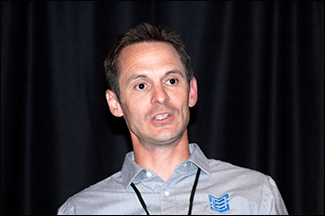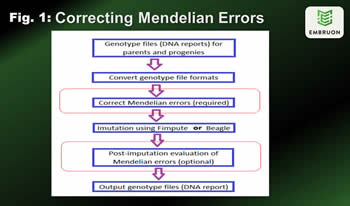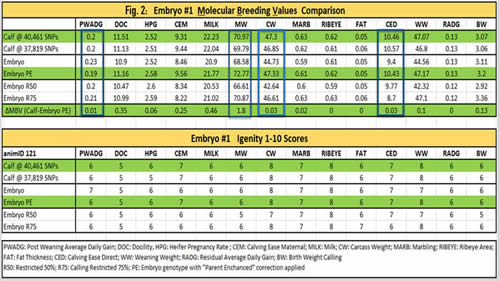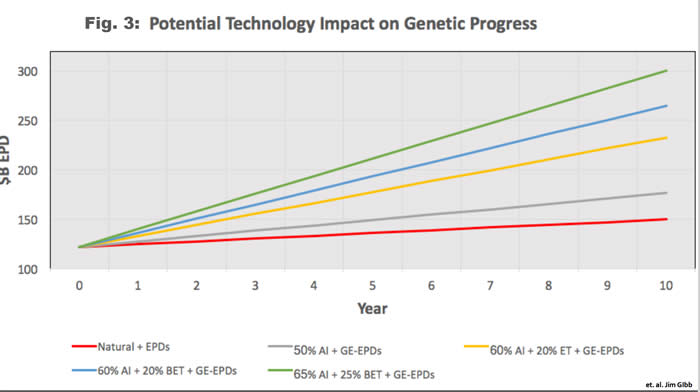Selecting Seedstock at
Minus 8 Months of Age
by Lindsay King, assistant editor, Angus Journal
LOVELAND, Colo., June 20, 2018 — Typically, flushing embryos is a game of chance. Producers transfer more embryos than necessary since they don’t know which ones they will want. Matt Barten, founder and president of Embruon, is revolutionizing the selection process of seedstock.

Matt Barten, founder and president of Embruon.
Started in 2014 as a navigational tool for seedstock producers, Embruon is a leader in the genomic industry today. Barten and his team can determine an embryo’s genotype before a pregnancy is even established, at roughly negative eight months of age.
“We are located in Salina, Kan., where we ship incubators out to producers to collect their embryos and they send them back to us for genomic evaluation,” Barten said.
Keeping it local, Barten offers a significant discount for Embruon’s services when embryo collections are done on-site. Typically, he refers clients to Glenn Engelland at Sun Valley Embryo Transfer (SVET). Barten saves time and money when clients work with SVET since he no longer has to prepare and mail incubators for the embryos.
As an added bonus, transfers using fresh embryos boast a 55% pregnancy rate, while transfers with frozen and subsequently thawed embryos average a 45% success rate.
“We keep trying to push our ability to discern everything we can about an embryo through a partnership with Neogen,” Barten said. “When genotyping the biopsies, we amplify the DNA. When we send those samples to Neogen, they run just like a tissue, hair or blood sample would.”
When looking at the DNA pulled from an embryo, Barten is magnifying the sample 2,100 times. To put it in perspective, one basket of corn kernels amplified at this rate would fill two straight-load semi-trucks.
 Since each sample is amplified to such an extreme, it should come as no surprise that errors within the DNA occur. To correct the Mendelian errors, Neogen is going through the steps outlined in Fig. 1. A project on 20,000 animals was completed the week of the BIF symposium to show the success of their error-removing process.
Since each sample is amplified to such an extreme, it should come as no surprise that errors within the DNA occur. To correct the Mendelian errors, Neogen is going through the steps outlined in Fig. 1. A project on 20,000 animals was completed the week of the BIF symposium to show the success of their error-removing process.
“This process is allowing producers to transfer embryos within a program without losing value,” Barten said. “Selling genotyped embryos, what would that be worth?”
Putting a dollar value on this type of program proved a challenge, but Barten and his team partnered with Dustin Aherin, a graduate student at Kansas State University, armed with a financial program converted to value real-time bovine in vitro fertilization (IVF) and embryo transfer (ET) (Fig. 2).

 They also figured it in $Beef and removed the bottom one-third of embryos that drag the average down, ultimately increasing the value (Fig. 3). Barten credits Jim Gibb for the line graph. Their ultimate goals were to show how producers can save money while also gaining genetic value.
They also figured it in $Beef and removed the bottom one-third of embryos that drag the average down, ultimately increasing the value (Fig. 3). Barten credits Jim Gibb for the line graph. Their ultimate goals were to show how producers can save money while also gaining genetic value.
“By transferring fewer, high-quality embryos with the genotypes producers want, the case for saving a significant amount of money can be made,” Barten added. “There is a 6.5% increase in ROI. This is starting to outpace the competition while saving money that can ultimately be invested back into an operation.”
Editor’s Note: The articles used within this site represent a mixture of copyrights. If you would like to reprint or repost an article, you must first request permission of Angus Media by contacting the editor at 816-383-5200; 3201 Frederick Ave., Saint Joseph, MO 64506. Angus Media claims copyright to this web site as presented. We welcome educational venues and cattlemen to link to this site as a service to their audience.


